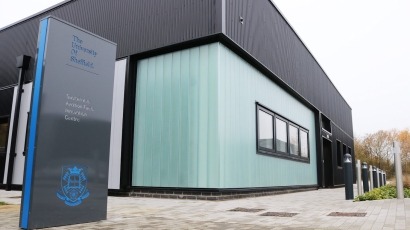
Expected to open in summer 2023, the Clearing House will be based across the University's Sustainable Aviation Fuels Innovation Centre (SAF-IC) and Translational Energy Research Centre (TERC) - two world-class research facilities unlike any other in the UK where academics and industry can work together to develop new low and zero-carbon fuels and technologies.
The SAF Clearing House is a major step in enabling the UK to bring new fuels to market and help reduce carbon emissions from the aviation industry.
The investment in Sheffield - together with the two research facilities located in the University of Sheffield Innovation District on the border of Sheffield and Rotherham - is establishing South Yorkshire as the UK's leading R&D hub for sustainable aviation fuels.
Professor Mohamed Pourkashanian, Head of the Energy Institute at the University of Sheffield, said, "We're thrilled to be able to announce the selection of the Energy Institute at the University of Sheffield as the home of the UK SAF Clearing House. This significant and much-needed addition to the UK's decarbonization landscape will help to reduce barriers to SAF delivery, and will take a vital step on the journey to make SAFs a viable solution for the future of aviation.
"With our world-class sustainable aviation fuels research and testing facilities at the Sustainable Aviation Fuels Innovation Centre (SAF-IC), as well as the significant amount of sustainable power to liquid capabilities at the neighbouring Translational Energy Research Centre and the expertise within the Energy Institute, we are ideally placed to drive forward the much-needed development, testing and delivery of SAFs."
He added, "This news follows the recent announcement that we're taking part in the first net-zero transatlantic flight, a project with Virgin, and our partnership with Boeing. These projects, in combination with our cutting-edge equipment and international, regional and local connections, puts the Energy Institute at the University of Sheffield at the center of the emerging sustainable aerospace sector.
"The UK SAF Clearing House, in partnership with Ricardo, is a major boost in connecting industrial capabilities with academic expertise, which will create the opportunity to make sustainable flight a reality, all on the path to a cleaner, decarbonized future."
Any new aviation fuel must meet strict fuel specifications before it can be certified as safe for use in aircraft. To reach this, fuel must undergo stages of testing against a process to meet the required ASTM standard. The cost and complexity of testing is a significant barrier to new fuels entering the market.
The UK Clearing House at Sheffield will provide advice to fuel producers on testing, signpost toward testing facilities and facilitate the certification of new fuels, drawing on the expertise and equipment at the SAF-IC and TERC facilities.
SAF-IC is the first of its kind in the UK to capture CO2, produce green hydrogen, convert them into sustainable aviation fuels and analyse their performance and technical sustainability in one location. TERC is one of the largest and best-equipped zero-carbon energy, hydrogen, bioenergy, CCUS and sustainable aviation fuels research and development facilities in Europe.
Both facilities are in the University of Sheffield Innovation District, which also includes the University's Advanced Manufacturing Research Centre (AMRC) and Nuclear Advanced Manufacturing Research Centre (Nuclear AMRC) - hugely successful blueprints for academic-industry collaboration.
Professor Koen Lamberts, Vice-Chancellor of the University of Sheffield, said, "The University is a leader in net zero innovation, and the world-class translational research facilities at the University of Sheffield Innovation District's growing green energy cluster will play a critical role in finding solutions to the greatest challenges facing society today.
"The announcement that our Energy Institute has been chosen as the home of the UK SAF Clearing House recognizes our research strengths in this important area, and is another example of how we are working with government and industry to pioneer the green technologies needed to decarbonise the aviation sector and meet net zero targets."

